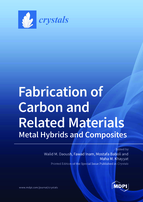Fabrication of Carbon and Related Materials/Metal Hybrids and Composites
A special issue of Crystals (ISSN 2073-4352). This special issue belongs to the section "Hybrid and Composite Crystalline Materials".
Deadline for manuscript submissions: closed (31 December 2021) | Viewed by 52139
Special Issue Editors
2. Department of Chemistry, College of Science, Imam Mohammad ibn Saud Islamic University (IMSIU), Othman ibn Affan St., P.O. Box 5701, Riyadh 11432, Saudi Arabia
Interests: fabrication of carbon fiber and carbon nanotube–metal matrix composites by powder technology; sintering; evaluation of the physical, chemical, biological activity, and mechanical properties of nanomaterials
Special Issues, Collections and Topics in MDPI journals
Interests: graphene; carbon nanotube; ceramics; polymers; nanocomposite; smart materials
Special Issues, Collections and Topics in MDPI journals
Interests: waste treatment; desalination; microbial fuel cell; polymeric membrane; renewable energy
Special Issues, Collections and Topics in MDPI journals
Interests: semiconductors; non-destructrive tests (indentation at micro & nano scales); solar cells; nanowires; thin flexible materials
Special Issues, Collections and Topics in MDPI journals
Special Issue Information
This Special Issue on “Fabrication of Carbon and related materials/ Metal Hybrids and Composites” focuses on novel developments and new processing methodologies in the fabrication and modification of carbon and its structure related materials and surface functionalization to improve its surface activities, catalytic application and to increase its adhesion to metals and its consolidation and sinterability for different applications. We invite high-quality submissions addressing current challenges in carbon/metal based materials preparation, including but not limited to the topics as listed below.
- Hybrid carbon/metallic materials
- Graphene and Graphene oxide hybrid materials
- Functionalization and surface treatments of carbon materials.
- Carbon/metal hybrid materials for removal of waste dyes.
- Carbon materials for catalytic application.
- Carbon materials for energy storage applications
- Carbon materials for water treatments application
- Carbon/metal hybrid materials for removal of waste dyes.
- Carbon fibers/ metal matrix composites
- Carbon nanotubes/metal matrix composites
- Graphite/metal matrix composites
- Diamond and related materials/metal matrix composites
Prof. Dr. Walid M. Daoush
Prof. Dr. Fawad Inam
Associate Professor Dr. Mostafa Ghasemi Baboli
Associate Professor Dr. Maha M. Khayyat
Guest Editors
Manuscript Submission Information
Manuscripts should be submitted online at www.mdpi.com by registering and logging in to this website. Once you are registered, click here to go to the submission form. Manuscripts can be submitted until the deadline. All submissions that pass pre-check are peer-reviewed. Accepted papers will be published continuously in the journal (as soon as accepted) and will be listed together on the special issue website. Research articles, review articles as well as short communications are invited. For planned papers, a title and short abstract (about 100 words) can be sent to the Editorial Office for announcement on this website.
Submitted manuscripts should not have been published previously, nor be under consideration for publication elsewhere (except conference proceedings papers). All manuscripts are thoroughly refereed through a single-blind peer-review process. A guide for authors and other relevant information for submission of manuscripts is available on the Instructions for Authors page. Crystals is an international peer-reviewed open access monthly journal published by MDPI.
Please visit the Instructions for Authors page before submitting a manuscript. The Article Processing Charge (APC) for publication in this open access journal is 2600 CHF (Swiss Francs). Submitted papers should be well formatted and use good English. Authors may use MDPI's English editing service prior to publication or during author revisions.
Keywords
- Hybrid carbon/metallic materials
- Graphene and Graphene oxide hybrid materials
- Functionalization and surface treatments of carbon materials
- Carbon/metal hybrid materials for removal of waste dyes
- Carbon materials for catalytic application
- Carbon materials for energy storage applications
- Carbon materials for water treatments application
- Carbon/metal hybrid materials for removal of waste dyes
- Carbon fibers/ metal matrix composites
- Carbon nanotubes/metal matrix composites
- Graphite/metal matrix composites
- Diamond and related materials/metal matrix composites









